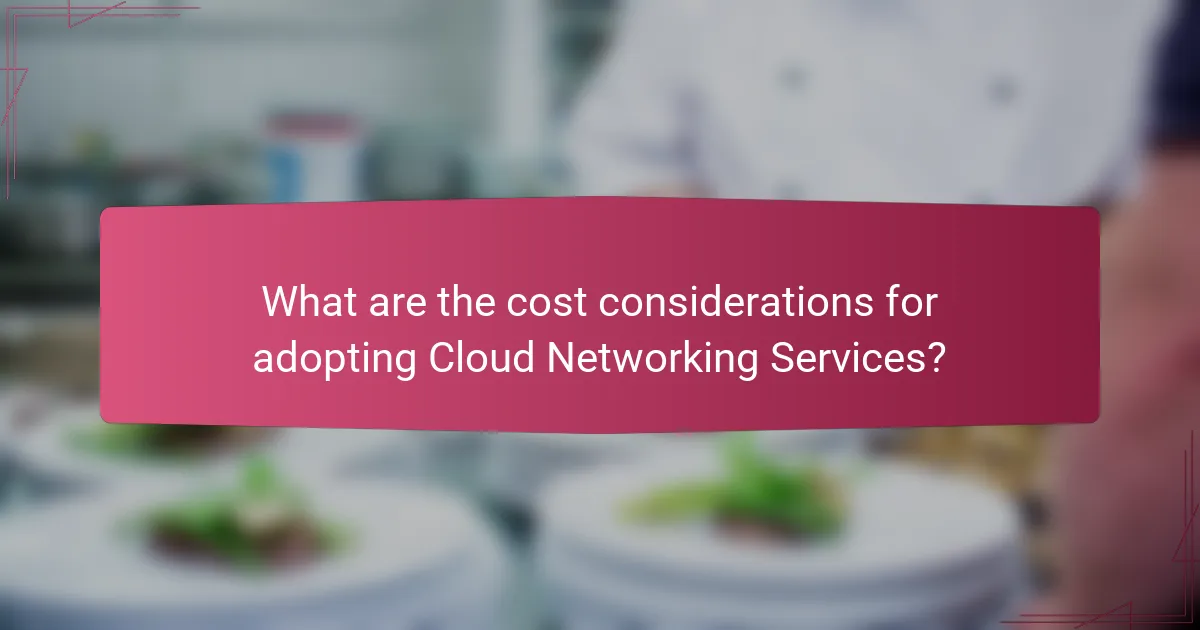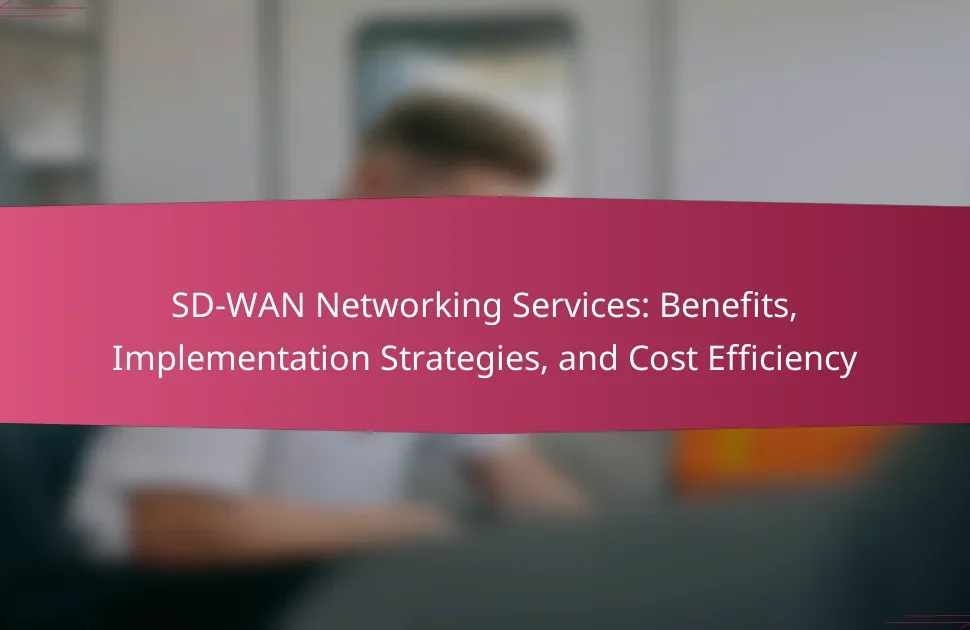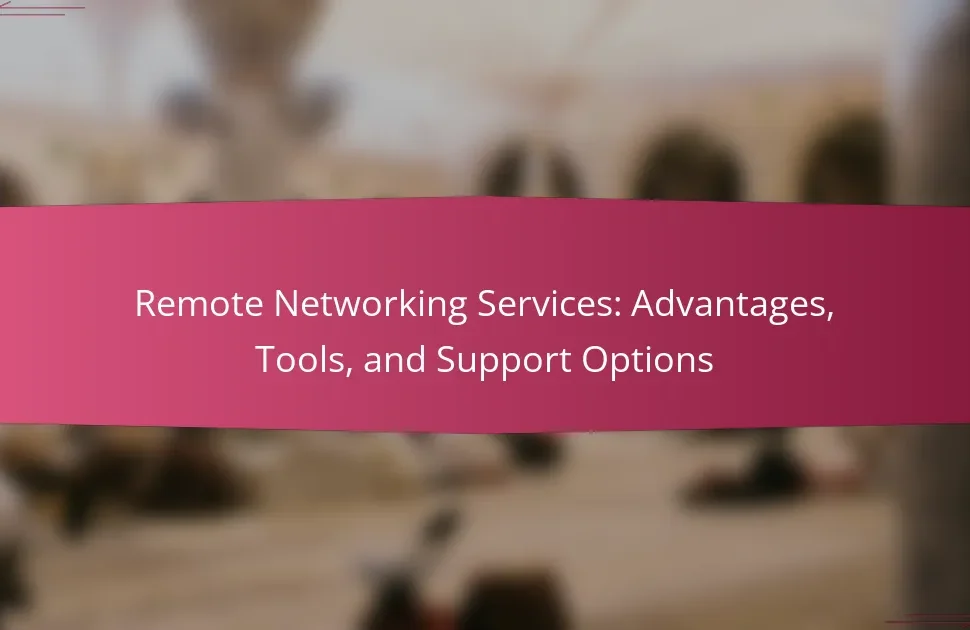
What are Cloud Networking Services?
Cloud networking services are solutions that leverage cloud computing to provide networking capabilities. They enable organizations to connect, manage, and optimize their network resources over the internet. These services include virtual private networks (VPNs), cloud-based firewalls, and software-defined networking (SDN). They allow for scalable and flexible network management without the need for physical infrastructure. Cloud networking services can enhance performance and reduce costs by utilizing shared resources. According to a report by Gartner, businesses can save up to 30% on networking costs by adopting cloud networking solutions.
How do Cloud Networking Services function in modern IT environments?
Cloud Networking Services operate by connecting various IT resources over the internet. They facilitate data transmission and communication between cloud-based applications and users. These services utilize virtualized network components to create flexible and scalable infrastructures. This allows organizations to expand their network capabilities without significant hardware investments.
Cloud Networking Services also enhance collaboration by enabling remote access to resources. They support multiple users across different locations seamlessly. Security measures, such as encryption and access controls, protect data during transmission. According to a study by Gartner, 80% of enterprises plan to increase their cloud networking investments by 2025. This trend underscores their importance in modern IT environments.
What technologies underpin Cloud Networking Services?
Cloud Networking Services are underpinned by several key technologies. These include virtualization, which allows multiple virtual networks to operate on a single physical infrastructure. Software-defined networking (SDN) separates the control plane from the data plane, enhancing network management and flexibility. Network functions virtualization (NFV) enables the virtualization of network services, reducing hardware dependency. Additionally, cloud computing platforms utilize APIs for seamless integration and automation of networking tasks. Security technologies, such as encryption and firewalls, are essential for protecting data in transit. These technologies collectively enable scalable, efficient, and secure cloud networking solutions.
How do these technologies improve connectivity and performance?
Cloud networking services improve connectivity and performance through enhanced bandwidth and reduced latency. These technologies facilitate faster data transfer between users and cloud resources. They utilize advanced routing protocols to optimize data paths. This optimization minimizes delays in data transmission. Additionally, cloud networking services offer scalability to accommodate varying user demands. This scalability ensures consistent performance during peak usage times. Furthermore, these technologies often employ content delivery networks (CDNs) to distribute data closer to end-users. CDNs significantly decrease load times by caching content in multiple locations. Overall, these improvements lead to a more efficient and responsive user experience.
What are the key advantages of using Cloud Networking Services?
Cloud Networking Services offer scalability, flexibility, and cost efficiency. These services allow businesses to quickly adjust their network resources based on demand. This adaptability supports growth without significant upfront investment in hardware. Additionally, cloud networking enhances collaboration by enabling remote access to resources.
Security is also improved through centralized management and advanced threat detection. According to a report by Gartner, organizations can reduce costs by up to 30% by migrating to cloud services. This financial benefit is a strong motivator for businesses to adopt cloud networking solutions. Overall, these advantages contribute to increased operational efficiency and competitiveness.
How do Cloud Networking Services enhance scalability for businesses?
Cloud Networking Services enhance scalability for businesses by providing on-demand resources and flexible infrastructure. These services allow companies to easily adjust their network capacity based on current needs. Businesses can increase or decrease resources without significant upfront investments. This flexibility supports growth and adaptation to market changes. For example, according to a report by Gartner, companies using cloud services can scale their operations by up to 30% faster. Additionally, cloud networking enables seamless integration of new technologies, which further enhances scalability.
What cost savings can organizations expect from adopting Cloud Networking Services?
Organizations can expect significant cost savings from adopting Cloud Networking Services. These savings stem from reduced hardware expenses. Cloud services eliminate the need for extensive on-premises infrastructure. Organizations can also lower maintenance costs associated with physical equipment. Scalability allows businesses to pay only for the resources they use. This model minimizes waste and optimizes budget allocation. According to a study by Gartner, companies can save up to 30% on IT costs by transitioning to the cloud. Additionally, cloud networking enhances operational efficiency, further contributing to financial savings.
How do Cloud Networking Services improve collaboration among teams?
Cloud Networking Services enhance collaboration among teams by providing seamless connectivity and real-time access to shared resources. These services enable team members to communicate through various platforms, such as video conferencing and instant messaging. They also allow for easy file sharing and collaborative document editing, streamlining workflows. According to a study by Gartner, organizations using cloud networking report a 20% increase in team productivity. This improvement results from reduced latency and improved access to tools and applications. Additionally, cloud services support remote work, allowing teams to collaborate from different locations without barriers. This flexibility leads to faster decision-making and innovation.

What security measures are essential for Cloud Networking Services?
Essential security measures for Cloud Networking Services include data encryption, access control, and regular security audits. Data encryption protects sensitive information during transmission and storage. Access control ensures that only authorized users can access cloud resources. Regular security audits help identify vulnerabilities and ensure compliance with security policies. Additionally, implementing multi-factor authentication adds an extra layer of security. Using firewalls can protect against unauthorized access and cyber threats. Monitoring and logging activities in real-time can help detect suspicious behavior. These measures collectively enhance the security posture of cloud networking services.
What are the common security risks associated with Cloud Networking Services?
Common security risks associated with Cloud Networking Services include data breaches, account hijacking, and insecure APIs. Data breaches occur when unauthorized individuals access sensitive information stored in the cloud. According to a report by IBM, the average cost of a data breach is $4.24 million. Account hijacking involves attackers gaining control of user accounts, potentially leading to unauthorized access to services and data. Insecure APIs can expose cloud services to vulnerabilities, making them susceptible to attacks. Additionally, loss of data control can happen when organizations cannot manage where their data is stored. Compliance violations may arise if cloud services do not meet regulatory standards. Lastly, insider threats can emerge from employees misusing their access to cloud resources.
How can organizations mitigate these security risks?
Organizations can mitigate security risks in cloud networking services by implementing robust security protocols. They should adopt strong encryption methods for data at rest and in transit. Regular security assessments and vulnerability scans are essential to identify potential weaknesses. Multi-factor authentication helps secure access to sensitive information. Employee training on security best practices reduces human error. Additionally, organizations should establish clear data governance policies to manage data access and usage. Implementing a comprehensive incident response plan ensures quick action in case of a security breach. Regular updates and patches to software and systems further protect against emerging threats. These measures collectively enhance the security posture of organizations utilizing cloud networking services.
What role does encryption play in securing Cloud Networking Services?
Encryption is essential for securing Cloud Networking Services. It protects data by converting it into a format that is unreadable without a decryption key. This process ensures confidentiality during data transmission and storage. Encryption also helps maintain data integrity by preventing unauthorized alterations. According to a 2021 report by the Cloud Security Alliance, 94% of organizations use encryption to secure their cloud data. This widespread adoption highlights its critical role in safeguarding sensitive information against breaches and cyber threats.
How do compliance and regulatory requirements impact Cloud Networking Services?
Compliance and regulatory requirements significantly impact Cloud Networking Services by dictating how data is managed and secured. These requirements ensure that sensitive information is protected in accordance with laws such as GDPR and HIPAA. Service providers must implement specific security measures to comply with these regulations. Non-compliance can result in hefty fines and legal repercussions. Additionally, compliance mandates can influence the design of cloud architectures. They may require data encryption, access controls, and regular audits. Organizations often need to allocate resources for compliance management. This can increase operational costs associated with Cloud Networking Services. Compliance not only affects technical aspects but also influences vendor selection and service agreements.
What standards should organizations adhere to when using Cloud Networking Services?
Organizations should adhere to standards such as ISO/IEC 27001 for information security management. This standard provides a systematic approach to managing sensitive company information. Organizations should also follow the NIST Cybersecurity Framework. This framework offers guidelines for managing and reducing cybersecurity risk. Compliance with GDPR is essential for organizations handling personal data of EU citizens. This regulation sets strict data protection and privacy requirements. Additionally, organizations must consider the PCI DSS if they process payment card information. This standard ensures secure handling of cardholder data. Following these standards helps organizations ensure security, compliance, and operational efficiency in cloud networking services.
How can businesses ensure they meet these compliance requirements?
Businesses can ensure they meet compliance requirements by implementing robust governance frameworks. These frameworks should include regular audits and assessments to identify compliance gaps. Training employees on compliance policies is essential for maintaining awareness and adherence. Leveraging technology solutions can automate compliance monitoring and reporting. Engaging legal counsel for guidance on regulatory changes is also advisable. Maintaining thorough documentation of compliance efforts provides evidence of adherence. Additionally, businesses should stay informed about industry standards and best practices. This proactive approach reduces the risk of non-compliance penalties.

What are the cost considerations for adopting Cloud Networking Services?
Cost considerations for adopting Cloud Networking Services include subscription fees, data transfer costs, and infrastructure expenses. Subscription fees vary based on service plans and usage. Data transfer costs arise from moving data in and out of the cloud. Infrastructure expenses can include hardware and software needed for integration. Additional costs may involve training staff and potential downtime during migration. Budgeting for scalability is also crucial, as usage may increase over time. Understanding these factors helps organizations make informed financial decisions regarding cloud networking.
How do pricing models for Cloud Networking Services vary?
Pricing models for Cloud Networking Services vary based on several factors. These factors include usage-based pricing, subscription-based pricing, and tiered pricing. Usage-based pricing charges customers based on the amount of resources consumed. This model is common for services like data transfer and storage. Subscription-based pricing offers a flat fee for access to services over a specified period. This model simplifies budgeting for businesses. Tiered pricing provides different levels of service at varying price points. Each tier includes a set amount of resources or features. Providers may also offer discounts for long-term commitments. According to a report by Gartner, 70% of businesses prefer flexible pricing models that align with their usage patterns.
What factors influence the cost of Cloud Networking Services?
The cost of Cloud Networking Services is influenced by several key factors. These include bandwidth requirements, data transfer volumes, and service level agreements (SLAs). Bandwidth requirements determine the speed and capacity needed for network performance. Higher bandwidth typically incurs higher costs. Data transfer volumes impact pricing based on the amount of data sent and received. More data usage can lead to increased fees. SLAs define the expected service quality and uptime guarantees. More comprehensive SLAs often result in higher costs. Additionally, the choice of provider and geographical location can affect pricing. Different providers have varying pricing models and regional costs.
How can organizations calculate their return on investment for Cloud Networking Services?
Organizations can calculate their return on investment for Cloud Networking Services by comparing the costs of implementation against the financial benefits gained. First, they should assess initial costs, including subscription fees and setup expenses. Next, organizations should evaluate ongoing operational costs, such as maintenance and support.
Then, they must quantify the benefits, which may include increased productivity, reduced downtime, and lower infrastructure costs. Organizations can utilize metrics like cost savings from reduced hardware needs and increased revenue from improved service delivery.
Finally, they can calculate ROI using the formula: (Net Profit / Cost of Investment) x 100. According to a study by Gartner, organizations can see up to a 15% reduction in IT costs through cloud services, supporting the financial benefits of this investment.
What are the long-term financial impacts of transitioning to Cloud Networking Services?
Transitioning to Cloud Networking Services can lead to significant long-term financial impacts. Companies often experience reduced capital expenditures as they shift from on-premises infrastructure to cloud solutions. This transition allows for a pay-as-you-go model, which can lead to more predictable budgeting. Operational costs may also decrease due to reduced maintenance and staffing needs associated with physical servers.
According to a study by Gartner, organizations can save up to 30% on IT costs by moving to the cloud. Additionally, cloud networking can enhance scalability, allowing businesses to adapt to changing demands without incurring high costs. Improved efficiency and productivity can result from streamlined operations and better resource allocation.
Moreover, the potential for innovation increases as companies leverage cloud services for new technologies. This can lead to new revenue streams and competitive advantages. Overall, the financial impact of transitioning to Cloud Networking Services can be substantial, with long-term savings and growth opportunities.
How can businesses budget effectively for Cloud Networking Services?
Businesses can budget effectively for Cloud Networking Services by assessing their current and future needs. They should analyze usage patterns and estimate data transfer requirements. Identifying essential services and potential growth is crucial. Businesses must also consider the pricing models of different providers. Understanding pay-as-you-go versus subscription plans helps manage costs. Additionally, companies should factor in hidden costs such as data egress fees. Regularly reviewing and adjusting the budget based on actual usage can optimize expenses. According to Gartner, organizations can save up to 30% by leveraging cloud services effectively.
What best practices should organizations follow when implementing Cloud Networking Services?
Organizations should follow several best practices when implementing Cloud Networking Services. First, they should conduct a thorough assessment of their networking needs. This includes understanding bandwidth requirements and application performance expectations. Second, organizations must prioritize security by implementing robust encryption methods and access controls. According to a 2021 report by Gartner, 95% of cloud security failures are due to customer misconfiguration. Third, they should ensure compliance with relevant regulations and standards. Regular audits help maintain compliance and identify vulnerabilities. Fourth, organizations should select a reliable cloud service provider with a strong track record. This can reduce risks associated with downtime and data loss. Lastly, continuous monitoring and optimization of the cloud network are essential for maintaining performance and security. Following these practices can lead to a more effective and secure cloud networking environment.
Cloud Networking Services are solutions that utilize cloud computing to provide networking capabilities, enabling organizations to connect, manage, and optimize their network resources over the internet. This article covers the functionality of these services in modern IT environments, the technologies that underpin them, and the key advantages they offer, such as scalability, flexibility, and cost efficiency. It also addresses essential security measures, common risks, and compliance requirements, as well as the financial implications and best practices for implementation. Overall, the article provides a comprehensive overview of how Cloud Networking Services can enhance organizational performance while ensuring security and compliance.




